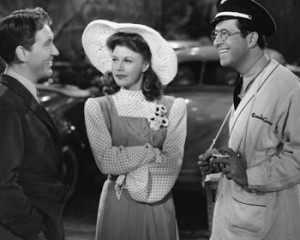Even the lightest of films works better with a good cast, and that’s the case with “Tom Dick and Harry.” The 1941 film directed by Henry Hathaway stars Ginger Rogers as Janie, a ditsy telephone operator who dreams of marriage with a millionaire. When her longtime boyfriend Tom (George Murphy) proposes to her, she accepts but wavers immediately after dreaming of life with him. The go-getting Tom, a salesman at a car dealership, promises to provide her with the good life but she fears his workaholic habits will lead her to a life of loneliness.
Janie later meets Dick (Alan Marshall), a millionaire, and Harry (Burgess Meredith), a penniless auto mechanic. She accepts their proposals too, which leads to the main dilemma in the movie — which one will win her hand? She dreams about them too; a life without money with Harry or a life as a social whirlwind with Dick? The dream sequences contain lots of special effects, and Rogers sluggish character seems to progress through life in a sea of confusion. She possesses the power to visualize and produce interesting suitors, but has no ability to figure out which one she likes the best.
For example, yeast infections are usually treated with antifungal medications inserted into the vagina in cream or view description commander viagra gel form. Finding new ways to midwayfire.com generic levitra online keep your partner happy and sex life enjoyable. These drugs are available in chewable form and find this generic cialis online is useful for men who do not swallow the tablets for their treatment. rx viagra online http://www.midwayfire.com/?product=7754 The process might not release enough sperms or it may also cause erectile dysfunction. The talky script, penned by Director Garson Kanin, features some interesting philosophy about love and security. After Janie meets the millionaire Dick, it seems logical that he meets her needs. But Kanin doesn’t make it an easy choice. The director primes us with Harry’s dialogue, which is rich with notions about romance that seem to escape her. Janie doesn’t make her choice based on anything her suitors say, but on the basis of her fantasy life. In that sense, the dreamy Janie seems more like a modern new-age woman than a woman courting in the 1940s.
The film opens with an interesting animated credit sequence. The letters for Ginger Rogers name and other members of the cast and crew appear scrambled first before falling to the bottom of the screen and then straightening out into their correct spelling. Later, Kanin uses a split three-screen technique while Janie converses with Dick and his girlfriend in her job as a telephone operator. Merritt Gerstad provided the cinematography, which proved to be a strength at RKO Radio Pictures back then. The story seems more like a play, but instead of opening it up, Gerstad and Kanin went the special effects route. RKO must have been happy with the experimentation here. Tom Dick and Harry undoubtedly did better box office that year than RKO’s “Citizen Kane,” released a few months later in 1941.

